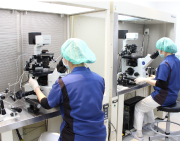

In the incubation room, oocytes and sperm from our patients are kept and handled, this is where they begin the process of new life.
For safety and sanitary concerns even amongst the clinic staff only certain members are allowed clearance to the incubation room.
In an actual incubation room, in order to reduce the stress on the oocytes caused by light, the lights are darkened, air conditioner and temperature is monitored, and cleanliness control is done thoroughly.
As for the incubation room where there is very little chance for us to see first hand what is going on, it is the place that we can call “the back stage of IVF”.
In order to provide a window into this world, we will talk about how IVF works there.
Embryologists are the engineers trained in advanced assisted reproduction who do the embryo cultures.
Embryologists take many paths, including clinical laboratory specialization, as well as studying things like agriculture and veterinary systems.
The two societies, the Clinical Embryologist Society and the Japanese Society of Mammalian Oocyte, both conduct the certification test, and the certification and licensing of Advanced Assisted Embryologist can be appointed.

The job of the bio-culture technician is to fertilize the oocyte with the sperm, keep the embryo and record its state, and until it is ready to be transferred back into the mother’s womb to be its keeper.
In actuality, it’s not only embryos that we are culturing, but there are many other things we are doing as well.
Embryo transfer is not performed immediately, the embryo is frozen and saved, also the culture is performed on the frozen and then thawed embryo for embryo transfer.
For embryologists, advanced skill and knowledge is required.
There are many difficult and detailed operations that require perfection, to err is unforgivable, in which discipline and experience are needed, and it will take many years to become one.
At Oak Group, we join and give presentations at various conferences, and also aggressively getting the latest on new skills and information.
We attend conferences and research meetings and while our staff our measuring the sharing of knowledge we are arranging preparations so that we can be of assistance to even only one set of parents to the many who desire a child in their lives.

Are you familiar with when in vitro fertilization skill began?
The skill and technology of ART, has been established by many researchers.
In 2010, at England’s Cambridge University, Honorary Professor Robert Edward was awarded the Nobel Prize for Physiology and Medicine in the “Development of In vitro fertilization technology”.
The first people in the world to successfully complete the process of IVF-Embryo Transfer were these Professor Edward and Professor Steptoe.
The child born by natural pregnancy at this time to Louise Brown, and a picture was taken with Professor Edward and published in the newspaper.
However, its application on human In vitro fertilization technology is opposed from the point of view of religious bioethics initially, and to get the research costs also seems difficult.
After the success, IVF became very popular desire for infertility treatment and spread over the world.
In Japan, in 1983, five years after the 1978 success of Professor Edward’s IVT-ET, Dr. Suzuki and colleagues at Tohoku University had their first success as well. Since then, we have made great strides in this area.
Compared to the time of Professor Edward and colleagues, it is thought that the development of medicine and equipment, machinery, and culture fluid has advanced, and the IVF skill now has remarkably progressed.
The IVF skill has two ways, the first is to put sperm on the oocyte taken out of the body and allow to fertilize, which is the usual way, and the second is to use a special needle to inject sperm directly into the oocyte and allow to fertilize.
The first success in micro insemination in the world was performed in Belgium in 1992.

If we look at it this way, we can see that from the first success of IVF-ET until now there has not been a long history.
However, it is said that in Japan 1 out of 56 persons about 20,000 persons per year, and in the world 4,000,000 persons per year are born by IVF skill.
Here at Oak Group we are continuing our research and hoping that everyone will be able to get the results they want as the skill develops.
"In vitro fertilization" is described here.